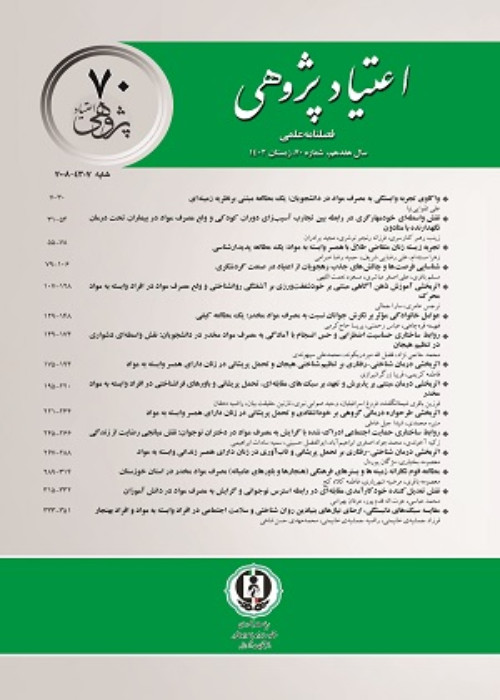The Relationship between Family-Social Factors and Substance Use: the Mediating Role of Individuals' Temperament, Character, Psychological Capital, and Beliefs
Author(s):
Article Type:
Research/Original Article (دارای رتبه معتبر)
Abstract:
Objective
The aim of this study was to investigate the relationship between family-social factors and substance use through the mediating role of the components of temperament, character, psychological capital, and beliefs.
Method
A descriptive-correlational research method was employed for the conduct of this study. All the 18-35-year-old male substance users in Qom who had presented to addiction treatment camps and Qom addiction centers in 2017 and 2018 constituted the statistical population of the present study. From among this population, the number of 320 participants was selected via convenience sampling method. Mohammadkhani's High-Risk Behaviors Questionnaire for Adults, Scale of Effective Factors in Drug Abuse Tendency among Youth, Cloninger's Temperament and Character Inventory (TCI), and Luthans Psychosocial Capital Questionnaire were the measurement instruments used for data collection in this study. The proposed model was evaluated using Confirmatory Factor Analysis (CFA) and Structural Equation Modeling (SEM) in Amos software.
Results
The model was revealed to enjoy desired fitness indices. Family had indirect effects on substance use through positive attitudes towards substances, self-directiveness, and resiliency. Friends had indirect effects on substance use through positive attitudes toward substances, harm avoidance, and self-directiveness. The market of substances indirectly affected substance use through the mediation of positive attitudes towards substance use. Moreover, positive attitudes towards substance use and high levels of harm avoidance had a direct and positive impact on substance use; and low levels of self-directiveness and resiliency had a direct negative effect on substance sue. From among the exogenous variables, friends with the coefficient of 0.303 had the highest indirect effect on substance use; and from among the mediating variables, harm avoidance with the coefficient of 0.782 had the highest direct impact on substance use.
Conclusion
The current findings were in line with those of similar prior studies and are considered an important step to explain the factors affecting substance use. The present findings can also be regarded as a model for the design of comprehensive prevention programs for high-risk behaviors.Keywords:
Language:
Persian
Published:
Research on Addiction, Volume:12 Issue: 46, 2018
Pages:
273 to 296
magiran.com/p1889824
دانلود و مطالعه متن این مقاله با یکی از روشهای زیر امکان پذیر است:
اشتراک شخصی
با عضویت و پرداخت آنلاین حق اشتراک یکساله به مبلغ 1,390,000ريال میتوانید 70 عنوان مطلب دانلود کنید!
اشتراک سازمانی
به کتابخانه دانشگاه یا محل کار خود پیشنهاد کنید تا اشتراک سازمانی این پایگاه را برای دسترسی نامحدود همه کاربران به متن مطالب تهیه نمایند!
توجه!
- حق عضویت دریافتی صرف حمایت از نشریات عضو و نگهداری، تکمیل و توسعه مگیران میشود.
- پرداخت حق اشتراک و دانلود مقالات اجازه بازنشر آن در سایر رسانههای چاپی و دیجیتال را به کاربر نمیدهد.
In order to view content subscription is required
Personal subscription
Subscribe magiran.com for 70 € euros via PayPal and download 70 articles during a year.
Organization subscription
Please contact us to subscribe your university or library for unlimited access!


